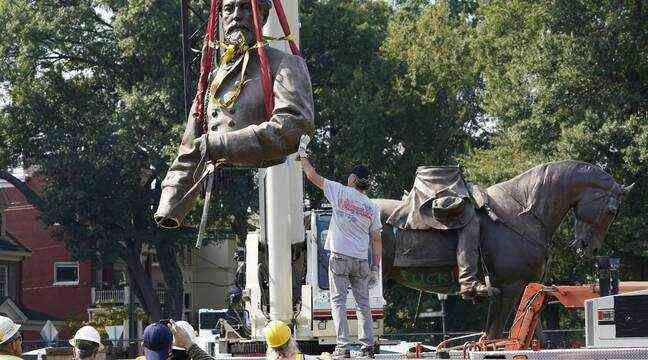A gigantic statue of General Lee, former commander of the Southerners and main military leader of the Confederates, was debunked Wednesday in Virginia in the United States. Denounced as a racist symbol in the country, the monument stood for more than 130 years on its 12-meter-high pedestal in Richmond, the former capital of the secessionists during the Civil War from 1861 to 1865.
She was gently lowered in front of a hundred people massed from a distance to attend the event. Some waved their fists, let out jokes or cheers when the imposing bronze piece, the work of French artist Antonin Mercié, was torn from its plinth. As a reminder, Robert Lee had fought with the States of the South against those of the North who had abolished slavery. This withdrawal “erases a stain on the history of Virginia and the history of America,” confided Muhammad Abdul-Rahman, a local association official.
Unbolting with great fanfare
While many Confederate monuments across the country were recently disassembled on the sly – sometimes in the middle of the night – under pressure from the Black Lives Matter movement, the Democratic Governor of Virginia, Ralph Northam, wanted to give it a national impact. to this unbolting. The monuments celebrating Robert Lee and the other great figures of the Southern States are today regarded as racist symbols by a good part of the Americans, others considering on the contrary that they are part of their historical heritage. The question remains sensitive.
Governor Northam had announced his intention to remove the statue of the Confederate General in June 2020, ten days after the death in Minneapolis of George Floyd, asphyxiated under the knee of a white policeman. The homicide of this African-American sparked a worldwide movement denouncing racial discrimination and vigorously revived the debate on the country’s slavery past. A judicial guerrilla war launched by supporters of keeping the Confederate statue – the largest in the country – in place – delayed the dismantling, finally validated last week by a decision of the Supreme Court of Virginia.
“Whose street is this?” Ours ! “
Proudly riding his thoroughbred, reins in hand, Robert Lee has a deliberately domineering posture. His statue, weighing 12 tons, peaked at the height of a six-story building. “Whose street is this?” Ours ! “Chanted on Wednesday the witnesses gathered on” Monument Avenue “, this boulevard in Richmond marked out until 2020 with other statues to the glory of the losers of the Civil War. This normally peaceful neighborhood has in fact become an epicenter of tension and contestation, as evidenced by the base of the statue, stained with graffiti and slogans calling on the police in particular to “be accountable”.
Given the sensitivity of the monument, the authorities had taken draconian security measures, temporarily banning traffic around the perimeter, drone overflights also being prohibited on Wednesday. Richmond “is no longer the capital of the Confederation,” said Levar Stoney, the African-American mayor of this city located south of Washington.
Further in the same state of Virginia, another controversial equestrian statue of General Lee, in Charlottesville, sparked violence in the summer of 2017, a white extremist going so far as to run into a crowd of anti-racist protesters in his car, killing a young wife. At the time, Republican President Donald Trump felt that debunking the statues of Southern officers amounted to “tearing” the history of the United States to pieces. Ermias Woldemariam, a resident of Virginia present at the removal of the statue, disagreed: “If people want to see it, it should be put in the museum. In any case not here, in full view of the population day after day ”.

